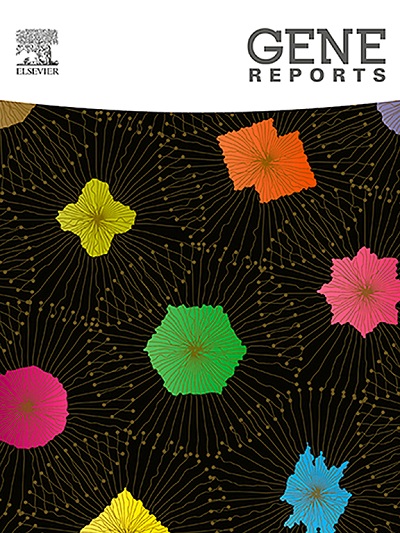Identifying the role of Casparian strip membrane proteins in rice under salinity stress
IF 1
Q4 GENETICS & HEREDITY
引用次数: 0
Abstract
Casparian strip (CS) is a specialized structure in endodermal cell layer of plant roots and is critical for regulating hydro-mineral transport and thus plant growth and stress responses. CS are synthesized and stabilized by a specialized class of proteins called CS-membrane-domain-proteins, the CS membrane proteins (CASPs) (CASPs). CASPs have been identified in various crops; however, such studies on Indica rice cultivars remain limited. This study was conducted to identify and characterize putative CASPs in Indica rice varieties, and their influence on expression patterns of key genes under salinity stress. The genome-wide screening revealed five putative orthologs in the Indica genome, three of them were confirmed as stable and functional CASPs through Eggnogg, Protparam, gene structure and domain architecture analysis. Cis-regulatory element analysis showed abscisic acid-responsive element (ABRE) and anaerobic responsive element (ARE) promoter within the promoter region, indicating their roles in regulating plant hormones, stress-responses, and influencing developmental processes. Subcellular localization confirmed their presence on plasma membrane. Three-dimensional structures prediction showed that all CASPs have four transmembrane architectures. To analyze responses under salinity stress, two Indica rice varieties differing in salinity tolerance abilities were studied for their responses to salinity stress including reactive oxygen species generation, lipid peroxidation, and responsive antioxidant enzyme activities. Varietal and stress-responsive differential enzyme activity was seen particularly for peroxidases, which are known to be involved in CS formation. Histochemical visualization for the development of CS using propidium iodide diffusion confirmed the varietal difference under salinity stress. Differential qRT-PCR-based gene expression of identified genes further confirmed the role of CS under salinity stress.
盐胁迫下水稻Casparian条带膜蛋白的作用鉴定
Casparian strip (CS)是植物根系内胚层的一个特殊结构,对调节水矿物运输、植物生长和逆境反应起着重要作用。CS是由一类特殊的蛋白质合成和稳定的,称为CS膜结构域蛋白,CS膜蛋白(CASPs) (CASPs)。CASPs已在多种作物中被鉴定;然而,对籼稻品种的此类研究仍然有限。本研究旨在鉴定籼稻品种中可能存在的CASPs,并分析其在盐胁迫下对关键基因表达模式的影响。全基因组筛选结果显示,籼菜基因组中存在5个同源基因,其中3个同源基因通过egggnogg、Protparam、基因结构和结构域分析证实为稳定的功能性casp。顺式调控元件分析显示,启动子区域存在脱落酸响应元件(ABRE)和厌氧响应元件(ARE)启动子,表明它们在调节植物激素、胁迫响应和影响发育过程中起着重要作用。亚细胞定位证实它们存在于质膜上。三维结构预测表明,所有CASPs均具有四种跨膜结构。为分析不同耐盐能力籼稻品种对盐胁迫的响应,研究了不同耐盐能力籼稻品种对盐胁迫的反应,包括活性氧生成、脂质过氧化和响应性抗氧化酶活性。品种和应激反应差异酶活性尤其见于过氧化物酶,已知其参与CS的形成。利用碘化丙啶扩散技术对CS发育进行组织化学可视化,证实了盐胁迫下的品种差异。基于qrt - pcr的鉴定基因差异表达进一步证实了CS在盐胁迫下的作用。
本文章由计算机程序翻译,如有差异,请以英文原文为准。
求助全文
约1分钟内获得全文
求助全文
来源期刊

Gene Reports
Biochemistry, Genetics and Molecular Biology-Genetics
CiteScore
3.30
自引率
7.70%
发文量
246
审稿时长
49 days
期刊介绍:
Gene Reports publishes papers that focus on the regulation, expression, function and evolution of genes in all biological contexts, including all prokaryotic and eukaryotic organisms, as well as viruses. Gene Reports strives to be a very diverse journal and topics in all fields will be considered for publication. Although not limited to the following, some general topics include: DNA Organization, Replication & Evolution -Focus on genomic DNA (chromosomal organization, comparative genomics, DNA replication, DNA repair, mobile DNA, mitochondrial DNA, chloroplast DNA). Expression & Function - Focus on functional RNAs (microRNAs, tRNAs, rRNAs, mRNA splicing, alternative polyadenylation) Regulation - Focus on processes that mediate gene-read out (epigenetics, chromatin, histone code, transcription, translation, protein degradation). Cell Signaling - Focus on mechanisms that control information flow into the nucleus to control gene expression (kinase and phosphatase pathways controlled by extra-cellular ligands, Wnt, Notch, TGFbeta/BMPs, FGFs, IGFs etc.) Profiling of gene expression and genetic variation - Focus on high throughput approaches (e.g., DeepSeq, ChIP-Seq, Affymetrix microarrays, proteomics) that define gene regulatory circuitry, molecular pathways and protein/protein networks. Genetics - Focus on development in model organisms (e.g., mouse, frog, fruit fly, worm), human genetic variation, population genetics, as well as agricultural and veterinary genetics. Molecular Pathology & Regenerative Medicine - Focus on the deregulation of molecular processes in human diseases and mechanisms supporting regeneration of tissues through pluripotent or multipotent stem cells.
 求助内容:
求助内容: 应助结果提醒方式:
应助结果提醒方式:


